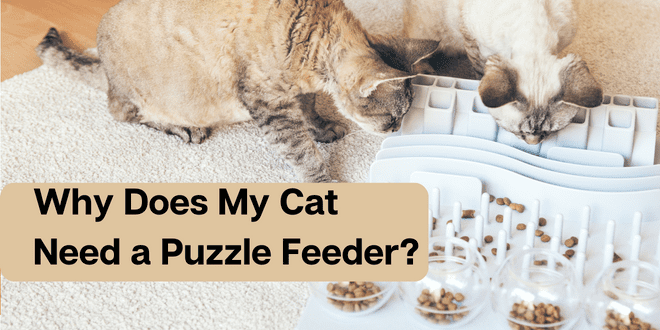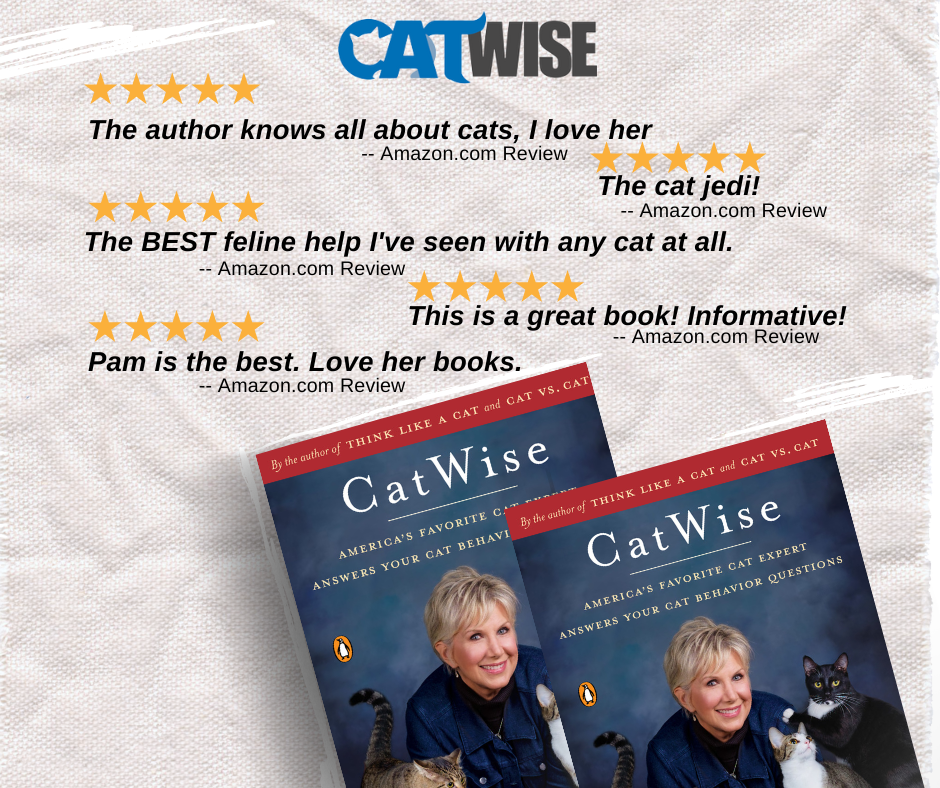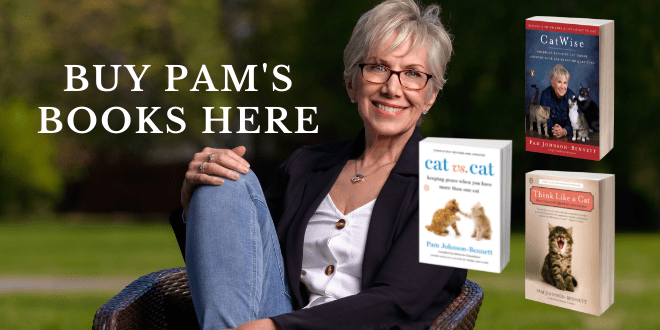
I’ve written before about the value of incorporating puzzle feeders (food-dispensing toys) into your cat’s daily life but if you’ve been reluctant to try it or are confused about how to begin, this article will take you through it step-by-step.
What’s a Puzzle Feeder?
A puzzle feeder is simply a food-dispensing toy. The cat figures out what movement of the toy is required to get a food reward and a game is born. You cat doesn’t technically need a puzzle feeder, but for many cats, it can be a very effective tool for adding mental stimulation into daily life. Your cat is a hunter and the natural way she would get her meals would be to hunt them down. In the wild there are no stainless bowls filled with mice or serving trays holding beautifully prepared birds and chipmunks. For the hunter to get her meal she must first stalk it, pounce and then capture her prize. For the hunter, a successful meal requires mental and physical stimulation. Many of us want our cats to stay indoors for safety reasons but then we don’t supply enough environmental enrichment to keep the cats mentally stimulated and physically fit. Using a puzzle feeder is just one aspect of an all-around enhancement of your cat’s day-to-day life.
What are the Benefits of a Puzzle Feeder for Cats?
Even the most basic food-dispensing toy may be a valuable tool when it comes to a variety of behavior and health issues. A puzzle feeder can:
- Encourage a cat to eat slowly
- Incorporate some reward-based solo playtime into your cat’s day
- Ease boredom
- Redirect a cat from engaging in destructive behavior
- Provide a little added exercise
- Encourage a cat to think and stay mentally stimulated
- Healthier option to free-feeding
- Aid in weight control
- May help with cats who are prone to vomiting (from eating too quickly)
Which Puzzle Feeder Should My Cat Use?
There are many commercially available puzzle feeders available at your local pet product store as well as online. They vary from basic to more complex. The type to use will depend on how quickly your cat gets the concept. Some cats immediately take to the puzzle solving idea and can work the food-dispensing toys quite successfully in a short amount of time. My cat, Pearl, has been able to master whatever puzzle feeder I present to her. She seems to truly enjoy the game. Other cats though, may need to start with the most basic concept of a container with a large enough hole where food falls out easily. The point isn’t to frustrate your cat but rather, to tap into her natural hunting and problem-solving skills.
An egg carton makes a wonderful level 1 puzzle feeder.
Can I make a Puzzle Feeder?
Homemade puzzle feeders are often the most entertaining and rewarding for both the cat and the cat parent. Before you go out and buy a puzzle feeder, start by making a simple one at home. One method is to make a water bottle feeder. Take an empty water bottle and cut holes in it that are bigger than the size of the treat. To start your cat off, make lots of holes in the bottle so your kitty will have immediate success just by touching the bottle. Once you’ve cut the holes in the bottle, put some dry food or treats in there and then place it on its side on the floor. Another option is to make a cardboard feeder using the tubular insert in the paper towel roll. Cut holes along the cardboard tube, fold in one end, put some dry food in there and then fold the other end closed.
Even plastic Easter eggs can become puzzle feeders. Cut a couple of holes in the plastic, snap the egg back together and you have an instant puzzle feeder. NOTE: Only make plastic and cardboard puzzle feeders if your cat doesn’t tend to chew on plastic or cardboard. If she does, you’re better off using a commercial puzzle feeder right from the beginning. When you do give your cat the homemade puzzle feeder for the first time make sure you supervise so you can be sure she won’t chew it. Also, use sandpaper to soften any sharp plastic edges around the dispensing holes to ensure that the experience will be pleasant for your cat.
Another homemade puzzle feeder can be made by cutting holes in a small cardboard box. Make the holes larger than the size of your cat’s paws so she can easily reach in for the food prize. Only use small boxes where your cat’s paw can easily reach in to get the food. Boxes that are too large will cause the food to sit in the center, totally out of your cat’s reach and that’s just frustrating.
What About More Complex Homemade Puzzle Feeders?
Collect the paper towel or bathroom tissue cardboard tubes and then tape them together in a pyramid style. If using paper towel tubes you’ll have to cut them in half. Attach the pyramid to a flat piece of cardboard and you have a honeycomb-style puzzle feeder where you can place treats in many different compartments. Use your imagination when it comes to creating puzzle feeders. Just keep in mind that you want the experience to be rewarding and not frustrating.
Another way to make the puzzles more challenging is to cut smaller holes in the water bottle, Easter egg, or tubular cardboard feeders. Always cut the holes larger than the size of the treat.
Can I Use Wet Food With Puzzle Feeders?
A simple wet food feeder is easy to make using a muffin tin or egg carton. Just place a little drop of food in each compartment so the cat has to walk around a little to discover each reward. Divide up the wet food into various dishes and place them around the cat’s play area to create a treasure hunt.
One puzzle feeder/slow feeder that’s perfect for wet food is the Lickimat. It’s a simple flat mat with raised nubs. Embed wet food in the mat and your cat will take more time licking it to get every morsel. There are several different Lickimat designs so you can find the one that best fits the type of food you feed.
Where Can I Buy Puzzle Feeders?
Do an online search for puzzle feeders and you’ll find many companies that make them as well as many videos with more how-to information. Not every commercial puzzle feeder is good though so take into consideration your cat’s age, personality, and health when choosing which product would be best. Many of the companies have videos on their sites so you can watch a tutorial on how the product works and whether it’s a good match for your cat.
Where Can I find More Information on Feeding My Cat?
If you have questions about what food is best for your cat and how much to feed, the place to start is at your veterinary clinic. Your veterinarian is the best person to advise you on the nutritional plan for your individual cat.
For more information on cat behavior and training refer to the books by Pam Johnson-Bennett. Pam’s books are available at bookstores and online. We’ve included links to Amazon here on our website.
If you have a question about your cat’s health, contact your veterinarian. This article is not intended as a medical diagnosis nor is it a replacement for your cat’s regular veterinary care. This article is for general information purposes only.




